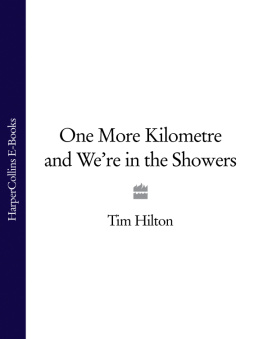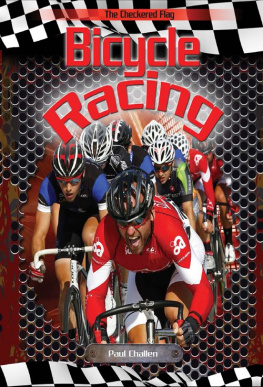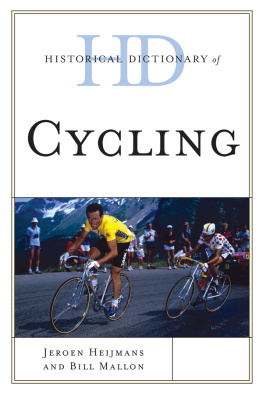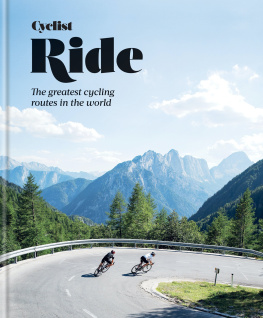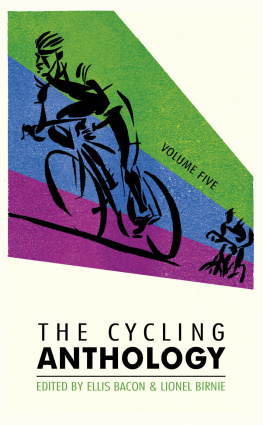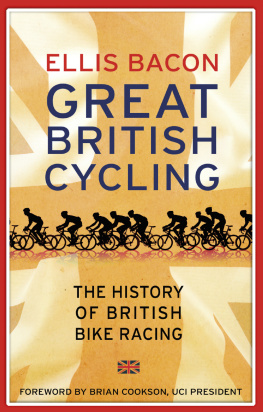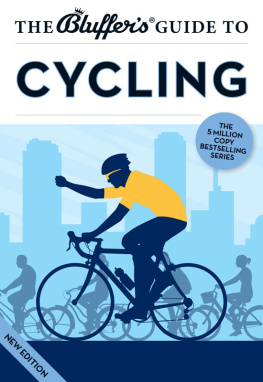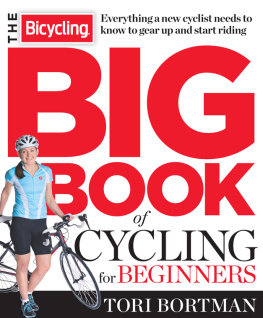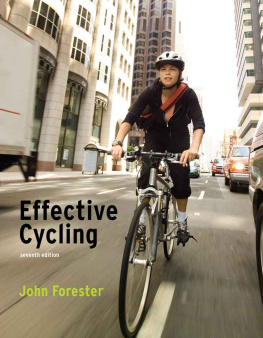
For Daniel
T his is a book about cycling and my enthusiasm for cycle sport. Its title was provided, in five seconds, by my son Daniel Hilton a super invention by a boy who was then in his twelfth year of life. I had complained that cycling books often have conventional tides, such as Reg Harriss Two Wheels to the Top (1976), Russell Mockridges My World on Wheels (1960) or Eileen Sheridans enchanting Wonder Wheels (1956). I enjoy these books. They remind me of the days when I grew up and first became a cyclist. That was some time ago. I have been cycling for half a century, so feel ready to contribute to the literature on wheelfolk, as we used to call ourselves. Like the poet he subsequently became, Daniel could not say how he devised his name for my book. It just arrived in my mind. Was it by any chance a metaphor, words spoken by defeated riders at the end of a long, hot race, just as elderly people might think of death? No, Dad.
Ours is a father-to-son sport and parents who are cyclists love to tell stories of the road to their children. I include some personal comment and passages of autobiography, and why not? Other people can describe the sport in a more measured way. I am not a sports historian, just a veteran club cyclist with a typewriter. None the less I have academic interests, of an undisciplined nature. My bound books on cycling are on shelves, more or less in order. The lists, Road Time Trials Council handbooks, pathetic training diaries, newspaper clippings, start sheets, photographs (some signed yours in sport or fraternellement), programmes, poems, Holdsworths Aids, gear tables, plus lovely maps of the high Pyrenees in the mid-1950s, are in cardboard boxes which I keep in the attic space above the library. I might hammer a bat box to the side of the building.
It is a curious fact that maps lose their beauty when framed and hung on the wall. They are beautiful because they want to be books rather than pictures. I wish that magazines could be regenerated as books. Other boxes and black bags, also roughly piled in the attic at the bottom of the garden, hold thousands of old cycling magazines, mostly English, many French, some Italian. All too few are the journals in Flemish: I must get some more next spring and work at the language. Modern-day cyclists ought to be linguists. Basque magazines would be interesting, though I do find the tongue daunting and am more at home in Belgium than en el Pais Vasco.
American cycling magazines mean little to me. I want old Flemish mags because like so many racing cyclists of my generation I feel increasing love for cycle racing in Flanders and wish that, when young, I had taken the boat to Ostend as often as to Calais. Wielersport is so old-fashioned and full of local patriotism. Like Flemish art, it is provincial in an admirable way. I mean old Flemish art a preference which indicates my antique view of the world. But the Ronde van Flaanderen, the Het Volk and similar events (let us include Paris Roubaix, though that race traverses French soil) are marvellously and essentially traditional. If they were to change with the times, all would be lost.
Paris Roubaix is criticised by some competitors, led by no less a man than Bernard Hinault, as absurd and having no place in the contemporary world. Hinault (the winner of the 79th edition, in 1981) speaks with feeling about its nonsense. My view is that of the thousands of fans who do not have to ride over those hideous roads to the north-east of Le Cateau-Cambrsis. We attend the Roubaix epic and the Ronde van Flaanderen because these races the Classics, the monuments of cycling take us back to grimy but glorious years in the past.
Is the Tour de France a monument? Unquestionably, because of its long and magnificent history. It is always an epic. Yet I join the whispers of discontent. The managers of the Tour always seem to be looking for extra revenues, new territories to conquer, a more contemporary style. I believe that the greatest years of the Tour came after the 193945 war, and before the mondialisation that was an objective in the mid-1980s. Younger people will no doubt have a different perspective. After all, the Tour is now more than 100 years old. Many lovers of la grande boucle prefer the race as it was in the 1920s and 1930s. To me, thats prehistory. I am a war baby, will be a war baby until death and associate cycle sport with the new European life after 1945.
My view of the Tour de France was formed in the 1950s. I can just glimpse that it was a period when, for the peoples of southern Europe, cycle racing provided a vague metaphor for the human condition. Those times have gone, but have left a legacy in the quasi-religious admiration of Fausto Coppi. We sense rather than define the end of European folk religion. But it is certain that the fortunes of dozens of riders tell us about the changes from peasant subsistence to life under industrialisation. Cycle sport also touches many other concerns of the twentieth century. First and maybe foremost, the freedom to go where one wills. Then, the development of technology; the attractions of positive leisure; commerce and advertising; the despoliation of the countryside; and the values of sport and popular culture.
In Paris in my teenage years I saw Fausto Coppi in action and took a photograph of him! Not a good one. At the same period I observed the rituals of English club runs and rode every spring to the cyclists annual gathering at the church at Meriden in Warwickshire. These dissimilar experiences were part of my novitiate, and the present book is concerned with differences between British and continental cycle sport.
A declining number of people know about the Meriden service. I doubt whether there is anyone who is not an old British cyclist who would recognise a Frank Patterson drawing, or salute the long history of the Clarion clubs, or give renewed applause to Ray Bootys 100 or Eileen Sheridans End-to-End. Ive written about such matters because they ought to be placed in a book. Our native cycling has long traditions that will soon be lost. Many cycling bodies are now about a century old. My own allegiances are of more recent times. They are owed to a network of clubs and individuals who came together in the later years of the last war, the British League of Racing Cyclists. Great rebels! Up the League! The BLRC was not merely about racing. It was a social movement. The League was made up of men (they were almost always men) who felt little respect for their elders and wished to have some experience of French and Italian life, if only from afar. They liked the thought of money but expected that their jobs would always be of an ordinary sort. Leaguers had had a strong sense of style and enjoyed glamour almost as much as they relished their disputes. They had no political agenda but would not be told what to do. And they have not gone away.
It is now difficult to trace the history of the British League of Racing Cyclists. The confusion is part of the Leagues anarchist legacy. Half a century on, its veterans often revisit old battles. Are these twinkling-eyed, grizzled men stirring the embers of memory? No. Their purpose is to pour paraffin into the fireplace. Many of them are still racing, though now in their seventies. Thats a part of cycling, a sport in a world of its own. Old wheelers continue in our youthful ways and do so until we drop from the tree. As the motto puts it, Were all young on the bike.
T he ebook edition of this book allows me to thank fellow cyclists whose help I forgot to acknowledge in the previous introduction. First among them is Eric Auty. Years ago he gave me his
Next page
